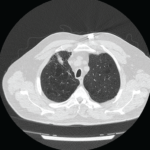4. Sjögren’s syndrome with nodules
“It’s important to remember that about 50% of the population will have lung nodules based on CT screening,” Dr Lee said. “If found, these nodules should be monitored according to Fleischner Society Guidelines to monitor for lung cancer. In Sjögren’s syndrome, lung nodules may represent pulmonary lymphoma, and positron emission tomography [PET] can be helpful in this situation if the lesion is approaching a centimeter in size. Prior to an invasive biopsy, I recommend talking to your friendly neighborhood oncologist.”4,5
5. Sjögren’s syndrome with pulmonary consolidation
Ten to 35% of pulmonary consolidation in Sjögren’s is caused by infectious pneumonia, especially given increased risk with immunosuppressants and loss of the normal mucociliary barrier. “However, other etiologies, such as organizing pneumonia and pulmonary lymphoma, should be considered if [the patient] does not improve or respond to empiric treatment [of their pneumonia]. The best test in most of these situations [i.e., patients with consolidation] is bronchoscopy,” Dr. Lee said.
In summary, pulmonary manifestations in Sjögren’s syndrome are common and variable. Some manifestations are asymptomatic, but some can have severe complications (e.g., ILD and lymphoma). Thus, vigilance is necessary. Biopsy is needed where neoplasm is a concern, although not typically required for evaluation of ILD or airway diseases.
“Overall, I recommend careful clinical screening of all patients [with Sjögren’s syndrome], including a baseline [chest radiograph] and complete PFTs. If the patient is symptomatic or has an abnormal PFT or [chest radiograph], a [high-resolution CT] with expiratory views should be considered,” Dr. Lee concluded.
Multidisciplinary Teamwork
Nancy Carteron, MD, FACR, clinical professor of medicine, Division of Rheumatology, University of California, San Francisco, health sciences clinical professor, Sjögren’s Clinic, Herbert Wertheim School of Optometry & Vision Science at the University of California, Berkeley, and rheumatology chair, Sjögren’s Foundation Clinical Practice Guidelines, addressed the multidisciplinary assessment and management of pulmonary manifestations in patients with Sjögren’s syndrome.
Dr. Carteron reinforced that lung involvement in Sjögren’s syndrome is common and under-recognized. She stressed the importance of early detection of pulmonary disease to optimize the care of our patients, especially because the diagnosis of Sjögren’s syndrome is often delayed.6 She championed a multi-disciplinary approach for the diagnosis and management of patients with Sjögren’s syndrome and pulmonary involvement.
“Collaboration improves diagnosis and decreases time to a consensus treatment plan. Disease knowledge can be shared across specialties, and the patient hopefully can see several specialists on the same day,” she said.

